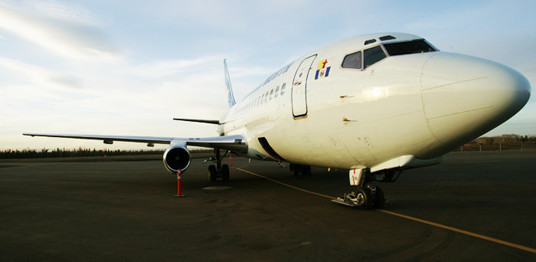CT301 Certificate Course
Elevate Your Ambitions, Expand Your Horizons
Step into the world of major airlines with our CT301 Certificate Course, specially curated for those who envision their future in the cabin of large national/international airlines or prestigious charter operators. This course isn't just about learning; it's about excelling in one of the aviation industry's most dynamic and challenging environments.
Dive deep into the functionalities and operations of the iconic Boeing 737 while also gaining versatile skills applicable to a range of narrow-body aircraft, including the Boeing 737-700 and Airbus A321. This program is your opportunity to master the art of collaboration, learning how to operate seamlessly alongside multiple flight attendants, ensuring safety and excellence in passenger service.
As you complete this comprehensive training, you will be honored with a Certificate of Completion from the Inflight Institute, a mark of your commitment, skill, and readiness to take on the aviation world. Whether you choose the digital certificate, ready to be emailed to your future employer, or prefer the tangible recognition with a printed certificate, your achievement will pave the way for a soaring career. Join us at the Inflight Institute and transform your aspirations into reality with the CT301 Certificate Course. The skies are calling!
This course applies to airlines such as...
- Flair Airlines
- WestJet
- Air Inuit
- Air North
- Aer Lingus (Ireland)
- Canadian North
- Lufthansa
- TUIfly (Germany)
- Enerjet
- …and more!

Course Outline
-
History of Flight
- What is a Cabin Crew Member
- History of Cabin Crew
- Theory of Flight
- Staying in the Air
- How Far We Can Fly
- ATC Their Role
- Global Geography (Continents)
- Time Zones
- 24 Hour Clock
-
Aviation Terminology
- Designator Codes (Airline & City)
- Phonetic Alphabet
- Acronyms

-
Regulations
- Around the World
- Regulations at Work
- Cabin Crew Manuals
- Amendments and Revisions
- Inspectors
-
A Day in the Life...
- Preparing for Duty
- Drug and Alcohol Policy
- Personal Image
- Personal Grooming Standards
-
Uniform Policy
- Looking Professional
- Requirements for Duty
-
At the Airport
- Check-In
- Check-In Duties
- Minimum Crew
- Chain of Command
-
One Crew Concept
- Crew Resource Management
- Importance of Effective Communication
- Verbal and Non-Verbal Communication
- Briefings
- Crew Briefings
-
Going to the Aircraft/Aircraft Type
- Categories of Aircraft
- Aircraft Type
- Crew Baggage
- Pre-flight Check
- Purpose of Equipment
- List of Equipment
- Minimum Equipment List
-
Standard Safety Procedures
- Screening of Passengers and Crew
- General Security Principles
- Dangerous Goods
-
Boarding
- Pre-Boarding
- List of Special Needs
- Deportees
- Prisoners and Escorts
- Special Needs Passenger Briefing
-
General Boarding
- Apron Safety
- Passenger Seating
-
Passenger Handling
- Customer Service
- Types of Complaints
- Abusive/Disruptive Passengers
- Failure to Comply
- Denied Boarding
- Captain's Authority
-
Freight and Baggage
- Carry-on Baggage
- Animals in the Cabin
- Baggage Stowage

-
Passenger Briefings
- Announcements and Techniques
- Electronic Devices
- Types of Devices
- Why Are There Restrictions?
- Reporting Device Interference
- Window Exit Briefings
-
Taxi
- Demonstration
- Visual Checks
- Flight Deck Communication
- Crew Seating
- Cabin Crew Stations
- Signals
- Silent Review
- Critical Phases of Flight
- Statistics
- Sterile Flight Deck
-
Inflight
- Take-Off
- Ordinance Signs

-
Inflight Service
- First Class Service
- Business Class Service
- Economy Class Service
- Flight Deck Service and Protocol
- The Glass Cockpit
- Jumpseat Authorization
- Service on the Ground
- Liquor Service
- Intoxicated Passengers
- World Standards on Disruptions
- Admittance – Locking of Flight Deck Door
- Safe Work Habits
-
Being Prepared
- Inflight Turbulence
- Pressurization Problems
- Pressurization System
- How It's Maintained
- Oxygen and the Body
- Rapid Decompression
- Engine Problems
- Propeller Abnormalities
- Time of Useful Consciousness
- Medical Issues
- Oxygen Administration
- Crew Incapacitation
- Pilot Jumpseats
-
Emergency Situations
- Inflight Fires
- How Fires Work
- Types of Fires-Classes
- Smoke and or Fumes
- Fire Detection
- Where Fires Can Happen
- Firefighting
- Cargo Firefighting
-
Other Types of Inflight Emergency
- Bomb Threats
- Hijacking

-
Preparing for an Emergency
- Emergency Briefings
- Emergency Landing Checklist
- Crew Coordination
- Briefing of Passengers
- Brace Positions
- Commands
- Purpose
- Techniques
- The Words
-
Categories of Landings
- When to Evacuate
- How to Evacuate
-
Post Evacuation
- Post Evacuation Procedures
- Duties
- Help on the Scene
-
Post Crash Survival
- Wilderness Survival
- Sea Survival
- Tropical/Jungle Survival
- Desert Survival
- Arctic Survival
-
Back in the Air
- Descent
- Duties upon Descent
-
Landing/Taxi-In
- Post Landing Duties
-
Deplaning
- Customs and Immigration
- Fueling With Passengers Onboard
- Gate and Apron Emergencies
- Aircraft Surface Contamination
- WHMIS
-
Flight Termination
- Overnights
- Logistics
- Conduct
- Personal Security
-
Flight Safety
- What is Flight Safety?
- Crew Responsibilities
- Some Examples
-
Conclusion
- Health and Wellness
- Eating Right
- Eating on the Run
- Exercise
- Jet Lag
- Deep Vein Thrombosis
- Medical Issues
-
Getting a Job
- Who Are My Potential Employers?
- Resume Preparation
- Interview Techniques
- Job Bank